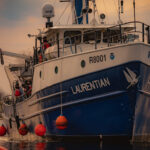Throughout 2024, NOAA’s Great Lakes Environmental Research Laboratory (GLERL) is proudly celebrating its 50th anniversary. But in addition to celebrating our own birthday, GLERL shares its anniversary with one of our most important assets – the R/V Laurentian. Added to our research fleet in 2002, the 80-foot Laurentian is GLERL’s largest vessel, and has many unique features that make it a fundamental component of our Great Lakes science. The Laurentian is based out of GLERL’s Lake Michigan Field Station in Muskegon, MI, and is a critical resource for GLERL – without which much of our science could not be accomplished.
The Laurentian was built for the University of Michigan in 1974, who operated it as a University National Oceanographic Laboratory System for the next 28 years. GLERL began leasing it from the University in 2002 and purchased it in 2017. This vessel is an incredibly versatile platform for GLERL’s ecological sampling, fisheries surveys, and deployments of advanced observing systems. There is extensive deck machinery, laboratory space, and onboard accommodations that can be adapted for various projects.

Not too big, not too small
At 80 feet long, the Laurentian’s size gives it some advantages of both larger and smaller vessels. A larger boat, such as the EPA’s 180-foot Lake Guardian, would require more people to operate, resulting in less flexibility with scheduling and weather delays. On the flipside, a smaller boat like GLERL’s 50-foot Storm would have more space limitations and less tolerance for wavy conditions. The Laurentian’s moderate size means it can be operated with as little as two crew on board, while still being large enough to handle rougher days on the lake.

“The Laurentian gives us the ability to be flexible and still accomplish the mission,” says NOAA GLERL Fishery Biologist Steve Pothoven, who conducts long-term monitoring and larval fish research on the vessel year-round.
Around the clock, throughout the year
One of the Laurentian’s most useful qualities is its ability to remain in the water year-round, thanks to its durable steel hull. While it doesn’t actively break ice, the Laurentian is the only GLERL vessel that doesn’t need to be removed from the water during the winter months. Its ability to endure Great Lakes winters allows it to be used into December – even January and February if there’s low ice – for crucial winter observations. Much remains to be learned about Great Lakes ecological processes during the winter months due to difficult fieldwork conditions, and the Laurentian’s wintertime capabilities help scientists capture critical ecosystem changes throughout the year.
The Laurentian’s flexibility isn’t just on a seasonal timescale – its ability to support overnight offshore research cruises is another major advantage. One of GLERL’s research areas that benefits from both overnight and winter observations is the observation of Mysis, a small Great Lakes crustacean similar to shrimp. Mysis are an important part of the Great Lakes food web, as they eat phytoplankton and zooplankton and serve as a food source for Great Lakes fish. They are sensitive to light and temperature, staying in deeper waters during daylight to avoid being eaten, and migrating toward the surface at night to feed. GLERL scientists regularly use the Laurentian for offshore, overnight research cruises to study this feeding behavior.

Additionally, Mysis breed during the winter, and studying the timing of their breeding cycle helps us understand how climate change is impacting their reproductive capacity. The Laurentian’s larger size makes it a perfect vessel for carrying out both overnight and wintertime cruises to study this important indicator of Great Lakes ecosystem health and balance.
A key element of GLERL’s science

Since GLERL’s addition of the Laurentian to its research fleet over 20 years ago, this vessel has been critical in supporting our research efforts. From daily to decadal research timescales, its unmatched versatility supports GLERL’s mission in the Great Lakes every day. The stories and resources below are just a few examples of GLERL’s groundbreaking science that could not be accomplished without a ship of the Laurentian‘s size and capabilities.

